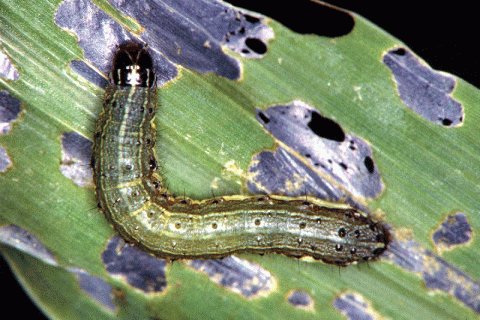Large Populations of Painted Lady Butterflies
January 8, 2018
In 2017 large populations of painted lady butterflies were seen across the state, raising concerns about whether the larvae form (thistle caterpillars) of this insect would cause damage to soybean fields. An article from the Proceedings of the 2018 Nebraska Extension Crop Production Clinics.
Scout Emerging Corn for Insects; Don't Take Protection for Granted
May 16, 2018
As corn begins to emerge, be alert to the potential for damage from early season insects such as cutworms, wireworms, white grubs or wheat stem maggot. Seed treatments provide some protection, but can be overwhelmed in some circumstances, allowing losses.
Corn Rootworm Management Update
January 8, 2018
From the 2018 Crop Production Clinic Proceedings: Corn rootworm continues to be a problem for Nebraska growers who rotate crops infrequently. Additionally, resistance to insecticides and some Bt corn reduces efficacy of these important tools in some fields.
Wheat Stem Maggot Adult Monitoring: A Pest of Cover Crop-to-Corn Transitions
April 25, 2018
This article looks at wheat stem maggots in cover crops-to-corn transitions, including their biology, risk for damage to early season corn, and what to look for this spring.
Timing of Cover Crop Termination and Related Factors
April 20, 2018
Should the cold spring delay cover crop termination? Growers walk a fine line between growing cover crops long enough to get the biomass they want without reducing yield in the following grain crop. This discussion from an agronomist, entomologist and weed scientist looks at various factors to consider.
Wheat Stem Maggot in Corn: Plan on Scouting Your Cover Crop Fields This Spring
March 8, 2018
Wheat stem maggots were an issue for some eastern and southern Nebraska farmers planting corn directly into a growing cover crop, leading to questions about how to best manage this scenario in 2018. Learn why entomologists don't recommend adding an insecticide to the herbicide when terminating the cover crop.
Check for Dectes Stem Borer Damage in Soybeans
October 27, 2017
The dectes stem borer has been expanding its range in Nebraska and university entomologists are now receiving damage reports from eastern Nebraska.
Which Bt Traits Do You Need to Purchase?
October 12, 2017
When it comes to buying corn seed, avoid investing in GMO insect protection you don't need. This guide looks at available traits and which proteins are effective on which pest species to help growers select the product best suited to their fields.







